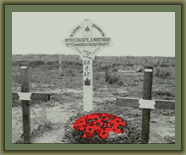Armistice Day
 An annual day of commemoration for
Canada's war dead began after the
First World War. With some 60,000 Canadians killed, the war produced a
profound sense of loss in a country whose greatest military tragedy to
date had been 267 dead in the South African War of 1899-1902. The huge
cost of the so-called "Great War" was truly stunning for Canada, as it
was for all combatant nations. As early as April 1919, Isaac Pedlow,
Member of Parliament (MP) for South Renfrew, introduced a motion in the
House of Commons to institute an annual "Armistice Day," to be held on the
second Monday of November. The term "armistice" denotes the cessation of
hostilities in a conflict, and it was used universally for the final
silencing of the guns that ended the First World War at 11 a.m. on
November 11, 1918.
An annual day of commemoration for
Canada's war dead began after the
First World War. With some 60,000 Canadians killed, the war produced a
profound sense of loss in a country whose greatest military tragedy to
date had been 267 dead in the South African War of 1899-1902. The huge
cost of the so-called "Great War" was truly stunning for Canada, as it
was for all combatant nations. As early as April 1919, Isaac Pedlow,
Member of Parliament (MP) for South Renfrew, introduced a motion in the
House of Commons to institute an annual "Armistice Day," to be held on the
second Monday of November. The term "armistice" denotes the cessation of
hostilities in a conflict, and it was used universally for the final
silencing of the guns that ended the First World War at 11 a.m. on
November 11, 1918.
Members agreed that there should be a special day to mark the Armistice,
but were split over the day on which it should be held. Responding to the
views of the veterans' community, many argued that it should occur on the
actual anniversary of the Armistice: November 11. Those who had come
through the war felt that a solemn occasion marking the deaths of 60,000
comrades was important enough to merit this distinction. A special appeal
sent out by King George V to the Empire on November 6, urging that the
year-old Armistice be marked by the suspension of all ordinary activities
and the observance of two minutes of silence at precisely 11 a.m. on
November 11 settled the issue. This was how Canada marked its first
Armistice Day.